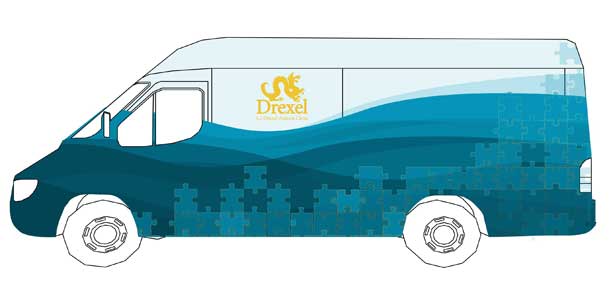Autism Outreach on Wheels: Students Design Mobile Clinics for A.J. Drexel Autism Institute
 By Rachel Ewing
By Rachel Ewing

The newly established A.J. Drexel Autism Institute at Drexel University is hitting the road with design assistance from students in the Antoinette Westphal College of Media Arts & Design.
Students are developing designs for the interior and exterior of a vehicle that will be used as a mobile clinic, the first mobile unit for autism in the Philadelphia region. Researchers and outreach staff from the Institute will use the vehicle to conduct clinical testing as part of autism research studies. It will also support community-level interventions that promote early diagnosis and effective interventions, especially in underserved communities. The vehicle will also be used to raise awareness of the A.J. Drexel Autism Institute, the nation’s first autism center focused on public health science.
“With the A.J. Drexel Autism Institute’s particular focus on public health, we wanted to be able to bring the best ideas from research to diverse communities – rolling out these vehicles will help promote engagement with diverse communities,” said Dr. Craig Newschaffer, director of the Institute and a professor in Drexel’s School of Public Health.
The vehicle design challenge is part of a six-week summer interior design course taught by Diana Nicholas, a professor in the Department of Architecture + Interiors. The undergraduate and graduate students participating include interior design majors Blanca Arzayus, Hattan Bakhit, Stephanie L. Heucke, Fay E. Leff, Maureen P. McMenamin, Christine Montemarno, Shannon N. Pruztman, Alexis Siriani, Yoshie Takeo and Lauren M. Young; graphic design majors Grace Lam and Ilana A. McLean; and architecture major Miguel A. Vargas.
The vehicle design challenge is part of a six-week summer interior design course taught by Diana Nicholas, a professor in the Department of Architecture + Interiors. The undergraduate and graduate students participating include interior design majors Blanca Arzayus, Hattan Bakhit, Stephanie L. Heucke, Fay E. Leff, Maureen P. McMenamin, Christine Montemarno, Shannon N. Pruztman, Alexis Siriani, Yoshie Takeo and Lauren M. Young; graphic design majors Grace Lam and Ilana A. McLean; and architecture major Miguel A. Vargas.
The mobile clinic will be used by clinical assessment teams making site visits to evaluate children taking part in research studies and participating in model programs. Visits will happen both at families’ homes and on-site at community service providers such as schools and health centers. For example, periodic home visits are a regular part of the Early Autism Risk Longitudinal Investigation (EARLI), a major national study directed by Newschaffer involving families with a child on the autism spectrum. The study looks at mothers of autistic children during a subsequent pregnancy and for three years after the birth of the new baby. The EARLI study is intended to help identify the complex causes of autism spectrum disorders. EARLI investigators collect biological and environmental samples from members of participating families and from their homes, and the children also receive behavioral and developmental assessments for autism spectrum disorders.
The mobile clinic will be used by clinical assessment teams making site visits to evaluate children taking part in research studies and participating in model programs. Visits will happen both at families’ homes and on-site at community service providers such as schools and health centers. For example, periodic home visits are a regular part of the Early Autism Risk Longitudinal Investigation (EARLI), a major national study directed by Newschaffer involving families with a child on the autism spectrum. The study looks at mothers of autistic children during a subsequent pregnancy and for three years after the birth of the new baby. The EARLI study is intended to help identify the complex causes of autism spectrum disorders. EARLI investigators collect biological and environmental samples from members of participating families and from their homes, and the children also receive behavioral and developmental assessments for autism spectrum disorders.
The vehicle’s exterior design presents different challenges: For research, a flexible design is essential. Any mention of “autism” on the exterior of the vehicle must be removable to protect the privacy of families and individuals involved in research studies. However, on other occasions the vehicles will be used for outreach and awareness at community and public events, where recognizing the connection to the A.J. Drexel Autism Institute is a desirable factor. The Institute’s advisors told students that the mobile assessment units should be approachable if parked in a community and have the ability to be branded in multiple languages for outreach to underserved, ethnically diverse communities.
Overall, the design concepts must present a vehicle that is safe, navigable, inviting and secure.
The designs will be judged by a panel of local community members with autism expertise. The groups with the winning designs will receive a financial award. The best aspects of all the designs will be incorporated into the custom-outfitted vehicle that will be ordered this fall.
The mission of the A. J. Drexel Autism Institute is to discover, develop and disseminate population-level and community-based approaches that will prevent morbidity and disability associated with autism; and to address the needs of, and improve the quality of life for, individuals with autism of all ages and their families. Autism is believed to affect one in 88 U.S. children and perhaps up to 4 million U.S. adults, many of whom are undiagnosed.